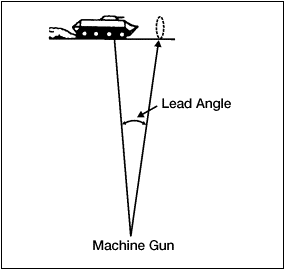|
Performance Steps
|
|
1. Assume a stable, prone firing position.
|
|
2. Align the sights on the target to get a correct
sight picture.
|
a.
Obtain sight alignment by
centering the front sight blade in the
aperture of the rear sight with the
top of the front sight blade even with
the top of the rear sight slide
(figure 071-312-3031-1).
|
|

Figure 071-312-3031-1.
Sight alignment
|
b.
Obtain a sight picture by
centering the target over the front
sight blade so it appears to rest on
top of the front sight blade and on
top of the rear sight slide (figure 071-312-3031-2).
|
|

Figure 071-312-3031-2.
Sight picture
|
|
3. Fire the M60 machine gun.
|
a.
Pull the trigger straight
to the rear.
|
b.
Say to yourself "Fire a burst of six."
|
c.
Release the trigger.
|
|
Note. This aids in controlling the number of rounds in each
burst and prevents excessive wear on
sear and sear notch.
Note. If you miss the target with your initial burst, you must
select a new aiming point the same
distance from the target as the center
of impact of the initial burst but in
the opposite direction, and fire a
second burst.
|
|
4. Adjust fire using the adjusted aiming point method
(figure 071-312-3031-3).
|
|

Figure 071-312-3031-3.
Adjusted aiming point method
|
a.
Observe the impact of
rounds in the target area by watching
the flight of tracer rounds or the
strike of rounds in the target area.
|
b.
Change your body position.
|
|
Note. Traverse means to move the muzzle of the weapon to the
left or right to distribute fire
laterally.
|
c.
Traverse the target area
with a bipod mounted M60 machine gun
by selecting successive aiming points
(figure 071-312-3031-4).
|
|

Figure 071-312-3031-4.
Traversing and searching
|
(1)
Shift your shoulders
slightly to the right or left for
minor changes in direction.
|
(2)
Move your elbows and align
the body to remain directly behind the
gun for major changes.
|
|
Note. "Search" means to move the muzzle of the
weapon up or down to distribute fire
in depth across the target area.
|
d.
Search the target area by
selecting successive aiming points,
changing elevation by moving your
elbows closer together or farther
apart (figure 071-312-3031-4).
|
|
5. Engage an area target using six- to nine-round
bursts.
|
a.
Determine the width and
depth of the target.
|
b.
Fire six- to nine-round
bursts until you hit the center mass
of the target area (figure 071-312-3031-5).
|
|

Figure 071-312-3031-5.
Center of mass
|
c.
Adjust fire by traversing
and searching to cover all the target
area.
|
|
6. Engage a point target using six- to nine-round
bursts (figure 071-312-3031-6).
|
|

Figure 071-312-3031-6.
Point target engagement
|
a.
Select a distinct aiming
point.
|
b.
Estimate range.
|
c.
Fire six- to nine-round
bursts to obtain accurate range and
deflection.
|
d.
Place effective fire on the
target by observing the rounds as they
impact in the target area. Make
necessary adjustments to hit the
target.
|
|
7. Engage a moving target using six- to nine-round
bursts (figure 071-312-3031-7).
|
|

Figure 071-312-3031-7.
Moving target engagement
|
a.
Estimate the speed of the
target and the lead required to fire
and hit it.
|
b.
Fire, tracking the target
as it moves.
|
c.
Adjust the lead by
observing tracers and the strike of
the bullets.
|
|
Performance
Measures
|
GO
|
NO GO
|
|
1. Assumed a stable, prone firing position.
|
—
|
—
|
|
2. Aligned the sights on the target to get a correct
sight picture.
|
—
|
—
|
a.
Obtained sight alignment by
centering the front sight blade in the
aperture of the rear sight with the
top of the front sight blade even with
the top of the rear sight slide.
|
|
|
b.
Obtained a sight picture by
centering the target over the front
sight blade so it appears to rest on
top of the front sight blade and on
top of the rear sight slide.
|
|
|
|
3. Fired the M60.
|
—
|
—
|
a.
Pulled the trigger straight
to the rear.
|
|
|
b.
Said to yourself "Fire
a burst of six."
|
|
|
c.
Released the trigger.
|
|
|
|
4. Adjusted fire using the adjusted aiming point
method.
|
—
|
—
|
a.
Made a minor change in
direction.
|
|
|
b.
Made a major change in
direction.
|
|
|
c.
Widened the impact area by
traversing.
|
|
|
d.
Raised the impact point by
searching.
|
|
|
|
5. Engaged an area target using six- to nine-round
bursts.
|
—
|
—
|
a.
Determined the width and
depth of the target.
|
|
|
b.
Fired six- to nine-round
bursts until you hit the center mass
of the target area.
|
|
|
c.
Adjusted fire by traversing
and searching to cover all of the
target area.
|
|
|
|
6. Engaged a point target using six- to nine-round
bursts.
|
—
|
—
|
a.
Selected a distinct aiming
point.
|
|
|
b.
Estimated range.
|
|
|
c.
Fired six- to nine-round
bursts to obtain accurate range and
deflection.
|
|
|
d.
Placed effective fire on
the target by observing the rounds as
they impacted in the target area. Made
necessary adjustments to hit the
target.
|
|
|
|
7. Engaged a moving target using six- to nine-round
bursts.
|
—
|
—
|
a.
Estimated the speed of the
target and the lead required to fire
and hit it.
|
|
|
b.
Fired, tracking the target
as it moved.
|
|
|
c.
Adjusted the lead by
observing tracers and the strike of
the bullets.
|
|
|